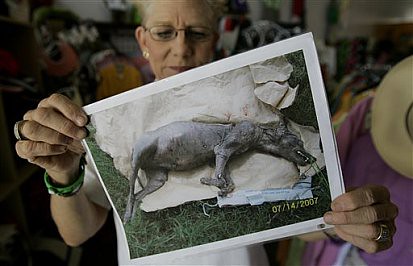A few years ago, there was a rash of bizarre, dog-like creatures turning up dead in Texas, which gave rise to a brief flurry of
chupacabra mania. Well, those disturbing-looking things are back, and all of the sudden chupacabra is chic again. Not only that, but chupacabra has even found its way into my day job routine.
This was written by
Marc Speir, a grad student of mine:

Witnesses say it looks like a cross between a dinosaur and a vampire. Others say it’s a hopping wolf with red eyes and a trail of foul smell, while some claim it resembles a small panther with a forked tongue.
Whatever the description, variations of the legend of the chupacabra can be found in Puerto Rico, Mexico, Nicaragua, Chile and Florida, among others. Originating in Puerto Rico, the name of the chupacabra, translated in Spanish as “goat sucker,” began with the macabre discovery of large numbers of dead goats.
The goats were found with puncture wounds in their necks and blood allegedly drained from their bodies. Confused farmers in rural Puerto Rican villages claimed that they saw strange animals attacking their livestock. These claims multiplied and eventually led to a widespread belief in the mythical beast.
Through the years, the mystery animal has supposedly been sighted, captured and killed in a handful of locales across the Americas. The most recent finding to make headlines is in Dewitt County, near the small town of Cuero, southeast of San Antonio.
Phylis Canion found the corpse of a strange-looking critter on her property in late July. Claiming that the animal killed numerous cats in the area and sucked the blood from her chickens for a number of years, Canion collected the blue-colored road kill off Highway 183. Upon closer inspection, she couldn’t place a name to it.
Determined to find out the identity of her discovery, she contacted KENS-5, a CBS broadcast affiliate in San Antonio. The news station was also curious, and sent a tissue sample to Texas State University-San Marcos for DNA testing.
The Department of Biology received the remains late this summer and is currently running tests to divulge the classification of the animal in the lab’s Beckman-Coulter CEQ 8800 DNA sequencer.
“This is part of a Mexican, Caribbean and Latin-American cultural phenomenon,” said Michael Forstner, professor of biology at Texas State and facilitator of the DNA tests. “While we don’t have the skull, from the images we have we can tell you that it’s a canid, it’s in the dog family Canidae.”
The reason the department doesn’t possess the skull is because the head of the animal was removed by Canion. She placed it in her freezer to preserve it for a decorative mount on her wall, leaving DNA testing as the remaining means in which to conclusively identify the beast.
“We’ll extract the DNA and amplify it using DNA markers suitable for mammals and carnivores,” Forstner said. “When we’re done, we’ll run the results against our online database and see what it matches.”
Supposed chupacabras that have undergone testing in the past often turn out to be wild dogs, foxes or coyotes. In this case, Forstner says the department should easily be able to find a match.
“If you’re asking me if this is a new life form, then I’d have to say no,” Forstner said.
The discovery has turned into national news, finding air on radio talk shows from Los Angeles to New York and being reported on television news stations across the country. The story even found its way into Jimmy Kimmel’s monologue, with the late-night talk show host joking that Canion had kept the remains to make “chalupacabras.”
Students around campus remain wary that such an animal exists.
“I was raised on the idea of the chupacabra--it’s silly folklore, like the boogeyman,” said Thomas Daniel, a criminal justice graduate from San Antonio. “My mom used to tell me that if I didn’t go to sleep, the chupacabra would take me away.”
Others say there’s a possibility that the creature may be grounded in reality, not just in the minds of misbehaved children.
“I don’t know if (the animal in the photo) is technically the chupacabra I’ve heard about in stories, but it’s something not ordinary,” said Luis Garza, international business senior from Brazoria. Garza studied the photograph of the animal closely before making his conclusion. “It could be a cross-breed… or genetic mutation.”
While scientists and students are skeptical of the legend, only the tests will tell for sure. The identity of the animal will be uncovered in a few weeks when DNA testing is complete.

2 comments:
Who knew the chupacabra could put Cuero on the map.
Even the name "chupacabra" sends chills down my spine on dark nights.... I don't mind ordinary boogeymen, but Fortian one's always get me. See the Mothman Prophecies film?
Post a Comment